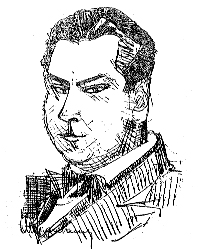
HORIA CREANGA (1892 - 1943)
After his graduation at the Ecole des Beaux-Arts in Paris (1924) and an internship in Gustav Umbdenstock's studio in Paris, from 1927 to 1943, H.Creanga designed in Romania more than 75 modern buildings: villas, apartment buildings, low-cost dwellings, important public buildings of different types, industrial buildings. For good reasons, his contemporaries used to consider his architecture the finest example of modernism in Romania, Creanga being the author of the first important modern building in the centre of Bucharest (the ten-storied ARO Building, apartments with movie theatre, designed in 1929). Consequently, his studio played the role of a "parallel school" for the younger architects. One could say that, by means of his projects, Creanga succeeded to disseminate the Modern Movement in Romania to the same extent than Marcel Janco did through his propaganda, fact that places both of them in the avant-garde of Romanian modern architecture.
Although he was not a theorist, but rather a "silent" character, the only six pages left from him are the most radical ever written during that period. His radicalism was two sided. On the one hand, the architect explicitly aimed at new aesthetics, whose expression was, in his opinion, "the horizontality", visually corresponding to the urban circulation of the motor-cars, and "the simplicity", which meant refinement and restraint, in a word, an "aristocraticalness" of forms. This elitist position, though unusual for the rhetoric of the Modern Movement, was quite revolutionary in the local context and an obvious opposition to the official academicism and sterile pursuits for a national style. On the other hand, through his designs, he implicitly achieved a remarkable typological revolution: he was the first and the only architect of that period who really transformed the urban villa into a modern one and processed the traditional type of the Haussmann-ian apartment building into a clear, simple, functional slab.
Moreover, in the 30s, his design for the Malaxa industrial complex (from which only the pipe factory is presented in the photographs) marked an unique moment in the development of modern architecture in Romania: a real artistic force challenging the myth of the epoch, the modern industry. Consequently, his design was mastered by a single, unequivocal gesture that included in the pure, megalithic volumes perfect spatial and functional organisation, structure and image. Thus, rejecting anything that could have altered the abstractedness and the asceticism of his radical design (the aristocraticalness he was seeking for), he reached a peak of formal efficiency never equalled until now in Romanian architecture.